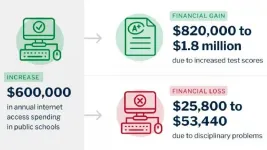The findings suggest that studying individual Achilles tendon shape (or 'morphology') could help with identifying patients at risk of injury and designing new, potentially personalised approaches for treating and preventing Achilles tendinopathy and similar conditions.
The Achilles tendon is the tissue that links the calf muscles to the heel bone. It is fundamental to our movement and athletic ability. Its unique structure, which combines three smaller sub-tendons, increases the efficiency of our movement by allowing individual control from connected muscles. For this control to occur, the sub-tendons must work together and allow a certain degree of sliding between them. But the ability of the sub-tendons to slide decreases with age, possibly accounting for the increased frequency of injury sometimes seen in later life.
"Each sub-tendon should be seen as an individual working unit within the whole Achilles tendon to fully understand how force is distributed within the tendon," explains lead author Nai-Hao Yin, a PhD student at the UCL Institute of Orthopaedics and Musculoskeletal Science, London UK. "But current medical imaging methods don't allow us to accurately visualise the borders of the sub-tendons in living people. This means the relationship between sub-tendon morphology, mechanical behaviour and injury risk is still unclear."
To help address this gap, Yin and colleagues began by studying five human Achilles tendon specimens, from two males and three females. They performed mechanical tests on the sub-tendons of the specimens to compare their differing mechanical properties. Next, they recorded the morphology of the sub-tendons of an additional three specimens, from two males, aged 54 and 55 years old, and one female, aged 14, which were selected to represent a diverse range of individual differences in tendon morphology.
"Our experiments showed distinct mechanical properties in the sub-tendons in keeping with their mechanical demands," Yin says. "We identified considerable variation in the orientation of the sub-tendons from different individuals."
The team then generated computer models using the data gained from their experiments. They applied a simulation technique to explore how different sliding properties affect sub-tendon movement and distribution of force within the different models. They were especially interested in the soleus muscle-tendon junction, as this location is widely used to measure tendon mechanical properties.
Next, they explored whether the results of their modelling experiments would reflect age-related decline in sub-tendon sliding in people. They recruited two groups of study participants: a group of seven older participants, aged 52-67 years old, and a younger group of nine participants, aged 20-29 years old. They applied electrical stimulation to the participants' calf muscles and recorded the changes that occurred in the junction. The older group of participants showed less sliding compared to the younger group, reflecting the same trend as the modelling result when the team studied the soleus sub-tendon in isolation.
"Our work shows that the mechanical behaviour of the Achilles tendon is highly complex and affected by a combination of factors, including sub-tendon mechanical properties and morphology, and age-related changes in their capacity for sliding," concludes senior author Helen Birch, Professor of Skeletal Tissue Dynamics at the UCL Institute of Orthopaedics and Musculoskeletal Science. "It also suggests that certain tendon morphologies may be more susceptible to injury in later life. We hope our findings will pave the way for further research on how these factors can affect sub-tendons differently among individuals, and ultimately lead to new injury treatment and prevention strategies."
INFORMATION:
Media contact
Emily Packer, Media Relations Manager
eLife
e.packer@elifesciences.org
+44 (0)1223 855373
About eLife
eLife is a non-profit organisation created by funders and led by researchers. Our mission is to accelerate discovery by operating a platform for research communication that encourages and recognises the most responsible behaviours. We aim to publish work of the highest standards and importance in all areas of biology and medicine, including Computational and Systems Biology, and Medicine, while exploring creative new ways to improve how research is assessed and published. eLife receives financial support and strategic guidance from the Howard Hughes Medical Institute, the Knut and Alice Wallenberg Foundation, the Max Planck Society and Wellcome. Learn more at https://elifesciences.org/about.
To read the latest Computational and Systems Biology research published in eLife, visit https://elifesciences.org/subjects/computational-systems-biology.
And for the latest in Medicine, see https://elifesciences.org/subjects/medicine.
About UCL - London's Global University
UCL is a diverse community with the freedom to challenge and think differently.
Our community of more than 41,500 students from 150 countries and over 12,500 staff pursues academic excellence, breaks boundaries and makes a positive impact on real world problems.
We are consistently ranked among the top 10 universities in the world and are one of only a handful of institutions rated as having the strongest academic reputation and the broadest research impact.
We have a progressive and integrated approach to our teaching and research - championing innovation, creativity and cross-disciplinary working. We teach our students how to think, not what to think, and see them as partners, collaborators and contributors.
For almost 200 years, we are proud to have opened higher education to students from a wide range of backgrounds and to change the way we create and share knowledge.
We were the first in England to welcome women to university education and that courageous attitude and disruptive spirit is still alive today.
We are UCL.
http://www.ucl.ac.uk| Follow @uclnews on Twitter | Watch our YouTube channel | Listen to
UCL podcasts on SoundCloud | Find out what's on at UCL Minds | #MadeAtUCL
Find out how UCL is helping lead the global fight against COVID-19 http://www.ucl.ac.uk/covid-19-research



